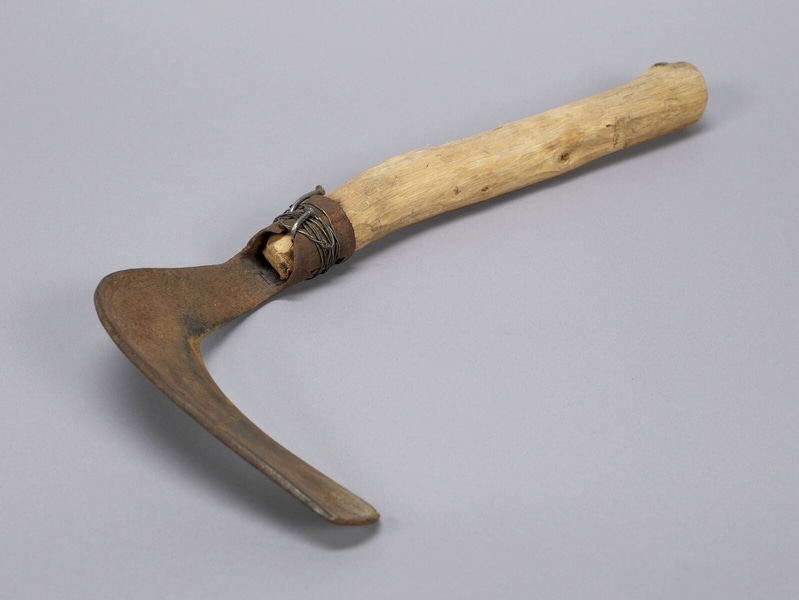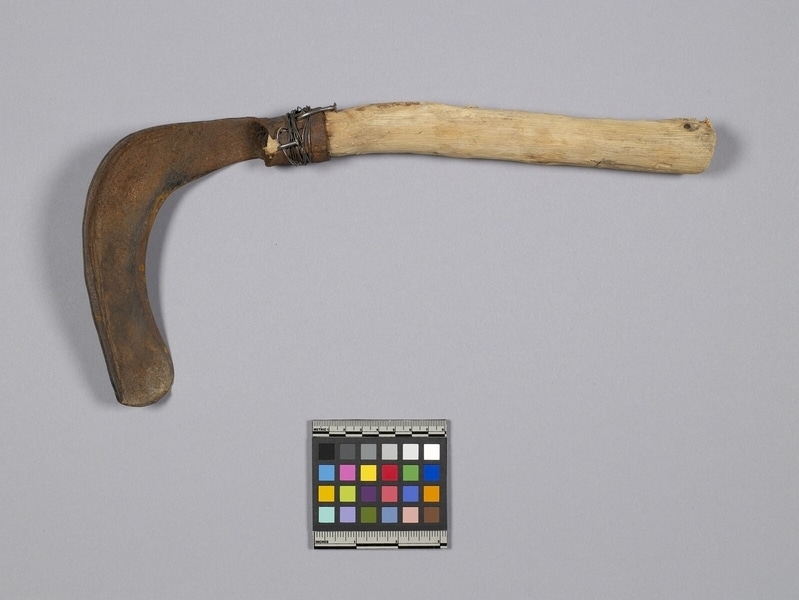Sickle Item Number: Edz1103 from the MOA: University of British Columbia


Description
Curved metal blade nailed and bound with wire to a straight, short wooden handle.
History Of Use
Such reaping knives were in common use, being employed primarily by women but occasionally by men. Until the 1960s Hakka women had primary responsibility for subsistence farming, as the men often worked elsewhere, or at occupations such as fishing. In the remote areas of Saikung, by the mid-twentieth century younger men often emigrated to urban areas of Hong Kong or overseas, to England or elsewhere, to try to make a living. In such cases any women left behind had to continue subsistence agriculture as well as depending on hoped-for remittances. Saikung was a poor area in which people depended on the gathering of marine resources as well as farming.
Knives like this had been used to harvest rice, which was no longer grown by the 1980s. A cluster of stalks was pulled up and gathered in the hook, and the knife then flipped over to cut the rice stalks.
After the mid-twentieth century the New Territories of Hong Kong began to undergo fundamental changes. The people who had been settled there before 1898, when the British colonizers claimed the area, began to give up rice agriculture and coastal fishing, turning instead to wage labour and increased employment overseas. By the end of the century, educational opportunities leading to the possibility of white-collar work also increased, together with western influences. These changes meant that objects and clothing once useful and appropriate were no longer needed and generally were discarded. Some were saved by their owners, who sometimes were willing to donate them to museums, sharing, also, their knowledge of how they were made and used.
Cultural Context
daily use
Narrative
Mrs. Lau donated this reaping knife to the Museum of Anthropology because she was elderly and was no longer able to carry out rice agriculture. In 1980, the remote villages of Sai Kung District were inhabited primarily by elderly people who were unable or unwilling to emigrate with their family members and depended on small-scale farming and hoped-for remittances.
Item History
- Made in Sai Kung, Hong Kong, China
- Collected by Elizabeth L. Johnson during 1979
- Owned by Elizabeth L. Johnson before March 17, 1980
- Received from Elizabeth L. Johnson (Seller) and Museum of Anthropology Shop Volunteers (Funding source) on March 17, 1980
What
Who
- Culture
- Chinese: Hakka
- Field Collector
- Elizabeth L. Johnson
- Previous Owner
- Elizabeth L. Johnson
- Received from
- Elizabeth L. Johnson (Seller) and Museum of Anthropology Shop Volunteers (Funding source)
Where
- Holding Institution
- MOA: University of British Columbia
- Made in
- Sai Kung, Hong Kong, China
When
- Collection Date
- during 1979
- Ownership Date
- before March 17, 1980
- Acquisition Date
- on March 17, 1980
Other
- Condition
- fair
- Accession Number
- 0610/0073